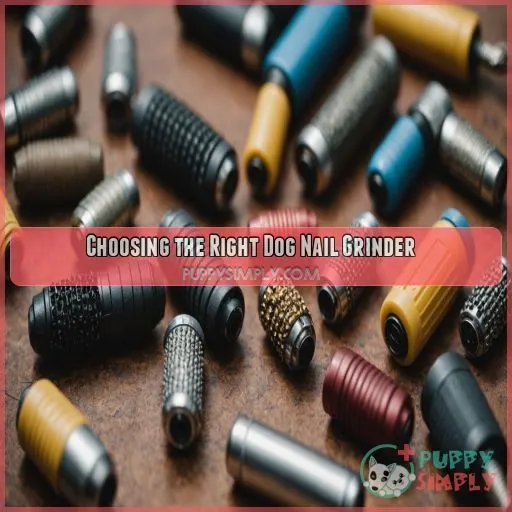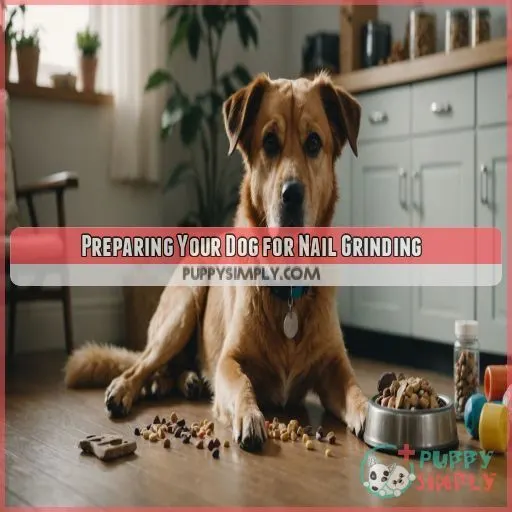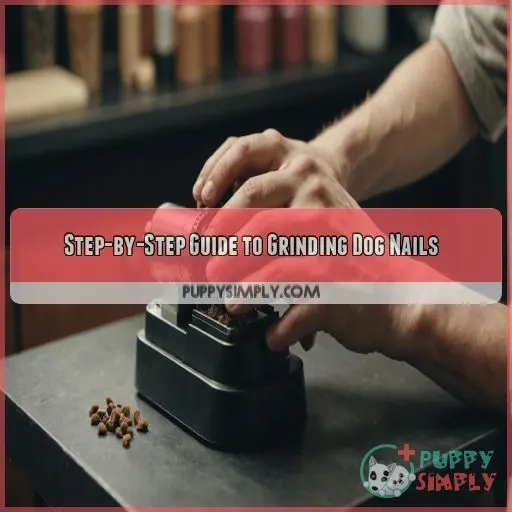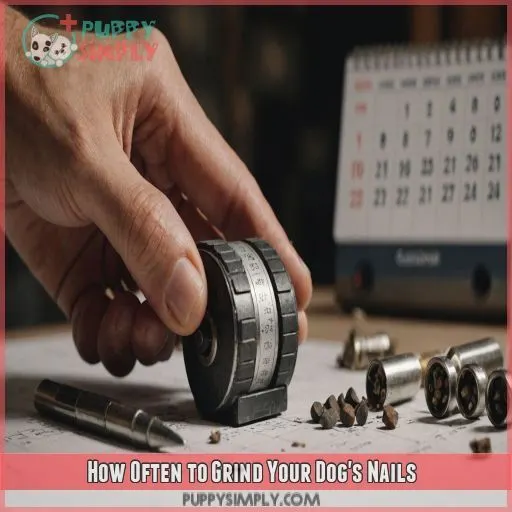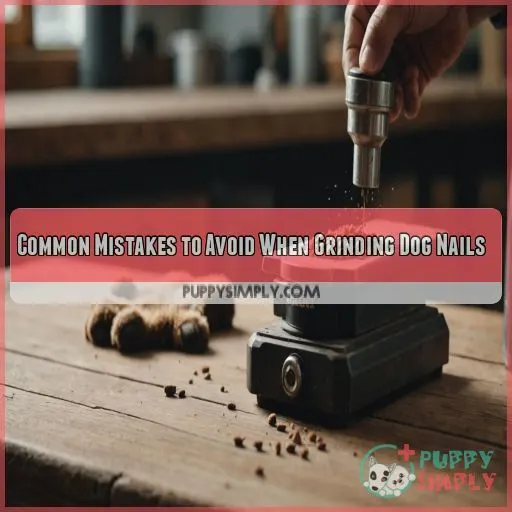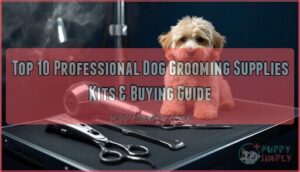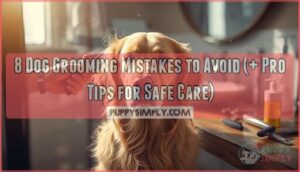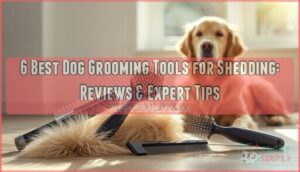This site is supported by our readers. We may earn a commission, at no cost to you, if you purchase through links.
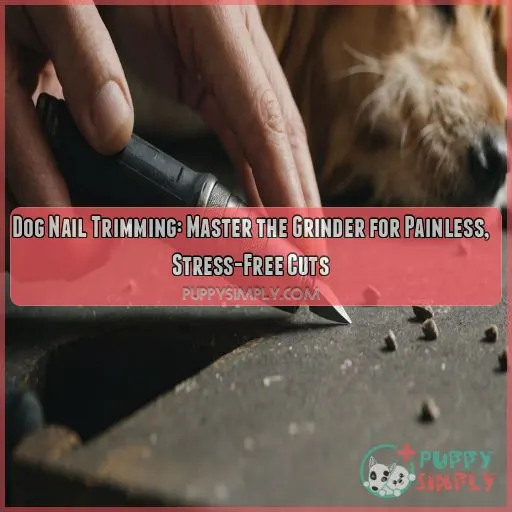
First, get your dog comfortable with the grinder’s noise and vibration – think of it as a nail-trimming warm-up.
Next, choose the right grinder size and type for your dog’s nail type and your comfort level.
Hold that paw securely, extend the nail, and grind away at a 45-degree angle.
Remember to take breaks and reward good behavior.
You’re on your way to stress-free, painless nail trims.
Now, let’s get into the nitty-gritty of mastering the grinder for a nail-trimming experience that’s a cut above the rest!
Table Of Contents
- Key Takeaways
- Choosing the Right Dog Nail Grinder
- Preparing Your Dog for Nail Grinding
- Step-by-Step Guide to Grinding Dog Nails
- Grinding Vs. Trimming: Which is Better for Your Dog?
- How Often to Grind Your Dog’s Nails
- Common Mistakes to Avoid When Grinding Dog Nails
- Frequently Asked Questions (FAQs)
- How do you use a dog nail grinder?
- Is it better to cut or grind dog nails?
- How far down should you grind a dog’s nails?
- What angle do you grind a dog’s nails?
- What safety precautions should I take when grinding dog nails?
- Can I grind my dogs nails if they are brittle?
- How do I grind my dogs nails without causing pain?
- Can I use a human nail grinder on my dog?
- What are the benefits of grinding dog nails regularly?
- Conclusion
Key Takeaways
- You’re about to become a pro at using a dog nail grinder! To avoid causing stress or pain, get your dog comfortable with the grinder’s noise and vibration – think of it as a nail-trimming warm-up. Start with a low volume and gradually increase exposure while rewarding good behavior with treats.
- Don’t try to cut corners – invest in a dog nail grinder that’s suited to your furry friend’s unique needs, ensuring a safe and painless experience. Choose the right grinder size and type for your dog’s nail type and your comfort level, and consider factors like speed, noise level, battery life, durability, and weight.
- To grind your dog’s nails like a pro, hold the paw securely, extend the nail with your thumb, and grind slowly at a 45-degree angle, taking breaks to give your furry friend a chance to relax. Remember to reward calm behavior with treats and praise to make the experience positive.
- By mastering the grinder and following simple steps, you’ll achieve painless, stress-free cuts that will leave your dog wagging its tail. Regularly grinding your dog’s nails helps prevent painful ingrown nails, reduces the risk of injuries, and eases chronic pain – that’s a pretty great feeling!
Choosing the Right Dog Nail Grinder
Getting the right tool is really important when you’re trimming your dog’s nails. It makes all the difference in having a painless and stress-free experience for both you and your furry friend! Choosing the right grinder size and type will help you become a pro at dog nail trimming and give your dog the comfort and care they deserve.
Importance of Grinder Size and Type
Get the right tool for the job! Choosing the correct grinder size and type is really important for a stress-free nail trimming experience. For small dogs, a compact grinder is perfect, while thicker nails require a more powerful type. Consider your dog’s nail type and your comfort level when selecting a grinder – it’s all about control and safety.
Features to Consider When Buying a Grinder
When buying a grinder, consider the speed – you want one that’s fast enough to get the job done, but not so fast it scares your pup. Look for a low noise level to minimize stress. Battery life, durability, and weight are also key. You want a grinder that’s easy to handle and won’t quit on you mid-session.
Safety Precautions When Using a Grinder
When using a dog nail grinder, prioritize your pup’s safety. Start with low grinder speed and gradually increase as needed. Be mindful of noise levels, taking breaks if your dog shows signs of stress. Protect those paws with a gentle touch and control the pressure. Regular grinder maintenance helps keep your dog’s nails healthy and the trimming process smooth.
Preparing Your Dog for Nail Grinding
It’s important to get your dog comfortable with the nail grinder to avoid stress or anxiety.
This includes getting them used to the grinder’s noise and vibration.
You can do this by gradually introducing the grinder and rewarding good behavior.
Getting Your Dog Used to the Grinder Noise
Now that you’ve chosen the right grinder, it’s time to get your dog comfortable with the noise. Start by simply turning it on and off while giving treats. Gradually increase the duration and volume to help your dog become desensitized. Here are some tips to make it a breeze:
- Begin with low volume: Start with the grinder on a low setting to avoid startling your dog.
- Associate noise with treats: Reward your dog with treats while the grinder is on to create a positive association.
- Increase exposure gradually: Gradually increase the duration and volume of the grinder noise over time.
- Watch for body language: If your dog shows signs of stress, stop immediately and try again later.
Desensitizing Your Dog to the Grinder Vibration
Getting your dog used to the grinder’s vibration can be a challenge.
You can use positive reinforcement and gradual exposure to help your dog become comfortable.
Start by introducing vibration toys or a cell phone on vibrate to create happy associations.
As your dog becomes more relaxed, introduce the grinder while giving treats and praise.
This noise desensitization process will make dog nail trimming a breeze, ensuring a stress-free experience for both you and your furry friend.
Trimming Hair From Paw Pads for Better Visibility
Now that your dog is comfy with the grinder’s vibration, it’s time to tackle those shaggy paw pads! Trimming the hair around the paws will give you a clear view of the nails, making it easier to grind. Use clippers or scissors specifically designed for pet grooming, and be careful not to nick the skin.
Rewarding Good Behavior During the Process
Rewarding good behavior is key to a stress-free nail grinding experience. Give your dog treats and praise them for staying calm and still. Positive reinforcement works wonders! Be patient and consistent, and your dog will learn to associate nail trimming with good things. Keep those dog treats handy and make nail trimming a breeze!
Step-by-Step Guide to Grinding Dog Nails
As you get ready to grind your dog’s nails, it’s important to follow a step-by-step approach to make sure it’s a painless and stress-free experience for both you and your furry friend.
By mastering the grinder and following these simple steps, you’ll be able to keep your dog’s nails healthy and well-groomed.
You’ll also strengthen the bond between you and your pet.
Holding the Paw Securely and Gently
Now that your dog is comfortable with the grinder, it’s time to get a good grip on that paw! Hold it securely, but gently, making sure not to apply too much pressure. Place your thumb on the pad to support the nail, and use your fingers to wrap around the paw, giving you control without causing discomfort.
Extending the Nail for Grinding
Now that you’re holding your dog’s paw securely, it’s time to extend the nail for grinding. Gently press the pad to make the nail pop out. Here are some nail extension techniques to keep in mind:
- Use your thumb: Press the thumb of the hand holding the paw to extend the nail.
- Hold the paw firmly: Secure the paw to avoid any sudden movements.
- Keep the nail straight: Align the nail with the grinder for a smooth grinding process.
Grinding Technique and Angle
Now that you’ve extended the nail, it’s time to grind. Hold the grinder at a 45-degree angle and move it from the base to the tip of the nail. Use short, gentle bursts to avoid overheating. The grinding direction and angle impact the nail shape, so be mindful of these factors to achieve a smooth finish.
| Grinding Direction | Nail Shape |
|---|---|
| From base to tip | Smooth, rounded |
| From side to side | Flat, uneven |
| Back and forth | Rough, jagged |
| In small circles | Shaped, defined |
Avoiding the Quick and Preventing Pain
Now that you’ve got the grinding technique down, it’s time to talk about the most vital part: avoiding the quick.
This sensitive part of the nail can be a real pain (literally!) if you accidentally grind too close.
To locate the quick, look for a slight curvature or a pinkish tint.
Keep a safe distance to guarantee a pain-free experience for your furry friend.
Taking Breaks and Giving Treats
Now that you’ve mastered avoiding the quick, it’s time to give your furry friend a break! Take a breather every 5-10 seconds to praise and reward your dog with treats, affection, or playtime. Choose low-calorie treats and time your praise strategically to associate nail grinding with positive experiences. This break frequency will keep your dog calm and cooperative.
Grinding Vs. Trimming: Which is Better for Your Dog?
In the matter of keeping your dog’s nails in check, you’ve got two main options: grinding or trimming. Let’s weigh the pros and cons of each method to determine which one is best for your furry friend.
Benefits and Drawbacks of Grinding Dog Nails
You’re considering grinding your dog’s nails – great choice! Grinding is a safe and painless way to trim your dog’s nails, ideal for thick or tough nails. It allows for precise control and helps reduce stress (Source). However, it can be more time-consuming and may require desensitizing your dog to the grinder’s noise and vibration (Source).
Benefits and Drawbacks of Trimming Dog Nails
Trimming your dog’s nails has its advantages and disadvantages. Trimming is quick and straightforward, but it can be challenging to see the quick, leading to painful mistakes. This method is ideal for thin or small nails, but may not be the best choice for anxious dogs or those with thick, tough nails.
Choosing the Best Method for Your Dog’s Nails
Choosing the best method for your dog’s nails boils down to their individual needs.
Grinding is perfect for thick or tough nails, while trimming suits thin or small ones.
Consider your dog’s nail type, temperament, and your own comfort level. By weighing the pros and cons, you’ll become a pro at picking the right nail care option for your furry friend.
How Often to Grind Your Dog’s Nails
As you master the art of grinding your dog’s nails, determining the right frequency is vital to keep those nails healthy and pain-free. By understanding the factors that affect nail growth, recognizing the signs of overgrown nails, and creating a personalized grinding schedule, you’ll be well on your way to becoming a nail-grinding pro!
Factors Affecting Nail Growth Rate
Grinding your dog’s nails requires attention to the factors that affect their growth rate. Your dog’s breed, age, nutrition, and health conditions all play a role. Here are the key factors that influence nail growth:
- Breed characteristics: Different breeds have varying nail growth rates.
- Age factors: Senior dogs tend to have slower nail growth.
- Nutrition impact: A balanced diet can promote healthy nail growth.
- Health conditions: Certain conditions, like arthritis, can affect nail growth.
Signs of Overgrown Nails and When to Grind
Now that you know the factors affecting nail growth rates, it’s time to spot the signs of overgrown nails. Keep an ear out for clicking sounds on hard surfaces, and an eye out for nails curling under paws or difficulty walking. If you notice these red flags, it’s grinding time! Typically, every 2-4 weeks is a good rule of thumb.
Creating a Nail Grinding Schedule for Your Dog
Create a nail grinding schedule that’s right for your dog’s breed, nail growth rate, and activity level. For most dogs, grinding every 2-4 weeks is ideal. Keep an ear out for clicking sounds on hard surfaces and watch for curling or difficulty walking. Stay on track, and your furry friend will thank you for the painless, stress-free nail care!
Monitoring Your Dog’s Nail Health
Monitoring your dog’s nail health is important to prevent painful issues. Check their nails regularly, ideally every week or two, to assess their growth rate, texture, and color. Also, inspect their paw pads for signs of irritation or discomfort. Here are three things to look out for:
- Nail splitting or cracking: A sign of dryness or damage.
- Changes in nail color: Indicative of potential infections or health issues.
- Paw pad irritation: A sign of discomfort or skin problems.
Common Mistakes to Avoid When Grinding Dog Nails
As you master the art of grinding your dog’s nails, it’s important to avoid common mistakes that can cause pain, stress, or anxiety for your furry friend. By being aware of these pitfalls, you can make sure you have a safe and enjoyable experience for both you and your dog, and keep those nails healthy and well-groomed.
Grinding Too Close to the Quick
Grinding too close to the quick is a common mistake to avoid. It can cause bleeding, pain, and stress for your furry friend. To prevent this, identify the quick by looking for a slight curvature or a pinkish tint. If you do accidentally cut the quick, apply styptic powder for quick bleeding control and pain relief.
Not Taking Breaks and Causing Stress
You’re halfway through grinding, but your furry friend is getting antsy. Don’t push through! Breaks are really important to avoid causing stress. Here are signs it’s time to pause:
- Paw sensitivity: If your dog shows discomfort or pain.
- Body language: Watch for tail tucking, yawning, or avoiding eye contact.
- Grinder anxiety: If your dog becomes fixated on the grinder.
- Restlessness: If your dog starts to squirm or whine.
Take a break, give treats, and resume when they’re relaxed.
Using the Wrong Grinder Size or Type
Don’t let the wrong grinder size or type ruin the experience for you and your furry friend! Choosing a grinder that’s too small or too large can lead to ineffective nail trimming, discomfort, or even injury. Make sure you select a grinder suitable for your dog’s nail size and type to avoid unnecessary stress and mistakes.
Not Rewarding Good Behavior and Causing Anxiety
Don’t forget to reward your furry friend for staying calm during nail grinding sessions. Not doing so can lead to anxiety and make future sessions a real challenge. By incorporating positive reinforcement, you’ll help your dog associate nail grinding with good vibes.
Here are 3 ways to reward good behavior:
- Treats: Give tasty treats during and after grinding.
- Praise: Offer genuine, enthusiastic praise for calm behavior.
- Breaks: Take regular breaks to let your dog relax and recharge.
Frequently Asked Questions (FAQs)
How do you use a dog nail grinder?
You’re about to become a pro at using a dog nail grinder! Hold the paw securely, extend the nail with your thumb, and grind slowly at a 45-degree angle, taking breaks to give your furry friend a chance to relax.
Is it better to cut or grind dog nails?
The age-old debate: to cut or grind those pesky pup nails? Well, friend, grinding is generally safer and more precise, especially for thick or tough nails, while cutting can be quicker but riskier, particularly for anxious dogs.
How far down should you grind a dog’s nails?
When grinding your dog’s nails, aim to shorten them to just before the quick, the pink part of the nail, to avoid pain and bleeding . Take breaks and reward good behavior to make the process stress-free.
What angle do you grind a dog’s nails?
Like a pro golfer lining up a putt, you want to get the angle just right! Hold the grinder at a 45-degree angle, grinding from base to tip, to safely and effectively trim your dog’s nails.
What safety precautions should I take when grinding dog nails?
When grinding your dog’s nails, hold the grinder at a 45-degree angle and avoid the quick (the pink part). Grind slowly, take breaks, and reward good behavior. If unsure, consult a veterinarian or professional groomer for guidance.
Can I grind my dogs nails if they are brittle?
Did you know 80% of dogs have nail problems? If your dog has brittle nails, grinding can be a bit tricky, but with the right technique and a gentle touch, you can still keep them healthy and safe.
How do I grind my dogs nails without causing pain?
To grind your dog’s nails pain-free, gently hold their paw, extend the nail, and grind in short bursts at a 45-degree angle, avoiding the quick. Reward calm behavior with treats and praise to make the experience positive.
Can I use a human nail grinder on my dog?
Don’t try to cut corners! Human nail grinders aren’t designed for your furry friend’s thicker nails. Invest in a dog nail grinder that’s suited to their unique needs, ensuring a safe and painless experience.
What are the benefits of grinding dog nails regularly?
Regularly grinding your dog’s nails helps prevent painful ingrown nails, reduces the risk of injuries, and eases chronic pain. By doing so, you’re taking control of their comfort and safety, and that’s a pretty great feeling!
Conclusion
Did you know that over 70% of dogs experience anxiety during nail trimming?
Mastering the grinder can be a game-changer for you and your furry friend. By following our simple steps and tips, you’ll be a pro at dog nail trimming: how to use a grinder in no time.
With practice and patience, you’ll achieve painless, stress-free cuts that will leave your dog wagging its tail. Happy grinding!

